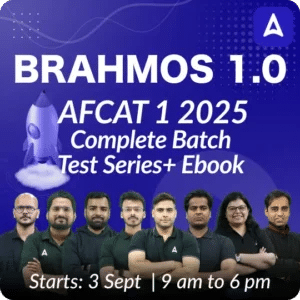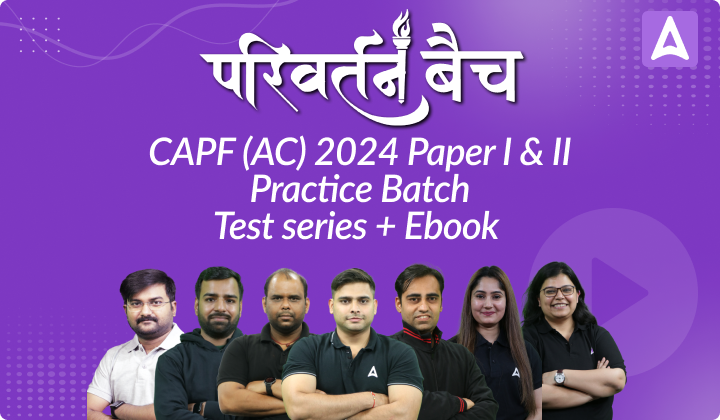The English Section in the AFCAT Examination carries significant weightage, making it a crucial component for candidates aiming to score well in the AFCAT Written examination 2025. Out of the total 100 questions in the AFCAT Written Exam, 30 questions are dedicated to English, accounting for 90 marks out of the total 300 marks. Each English question is worth 3 marks.
AFCAT English Questions
For candidates preparing for AFCAT 1 2025 Exam, it is essential to understand the types of English questions typically asked in the exam. This section evaluates a candidate’s proficiency in language skills, including vocabulary, grammar, comprehension, and verbal ability. The AFCAT English Questions are particularly seen from these topics of Synonyms, Antonyms, idioms and phrases, Jumbled Sentences, Active Passive voice, Direct and Indirect Speech, Tenses, Conjunctions, Prepositions, and so on.
Important AFCAT English Questions with Detailed Explanation
In this article, we will discuss the different types of English questions in AFCAT to help candidates gain insights into the pattern and level of difficulty. Familiarizing yourself with these question types will aid in better preparation and improve overall performance in the exam. Understanding the format of AFCAT English Questions and practicing accordingly will give candidates a competitive edge in this crucial section of the AFCAT 2025.
AFCAT English Questions for AFCAT 2025
AFCAT English Question 1:- Convert the following active voice statement to its corresponding passive voice formulation:
Senior management will finalize the merger agreement by the end of this fiscal year.
(a) The merger agreement will be finalized by senior management by the end of that fiscal year.
(b) The merger agreement will be finalized by senior management by the end of this fiscal year.
(c) The merger agreement is being finalized by senior management by the end of this fiscal year.
(d) By the end of this fiscal year, the merger agreement will have been finalized by senior management.
Solution 1. Ans. (b)
- Active Voice: Denotes that the noun or pronoun that acts as the subject in the sentence is the doer of the action.
- Passive Voice: Represents that the subject is acted upon by the action or verb.
- Rule for Conversion: To convert a future simple tense from active to passive voice, the structure changes as follows:
- Active: Subject + will + base form of the verb + object.
- Passive: Object + will be + past participle of the verb + by + subject.
- Applying the Rule:
- Active Voice: Senior management will finalize the merger agreement.
- Passive Voice: The merger agreement will be finalized by senior management.
- Thus, the correct answer is option (b) “The merger agreement will be finalized by senior management by the end of this fiscal year.”
This maintains the intended future action and the agent of the action, placing emphasis on the action’s impact on the object rather than who is performing it.
AFCAT English Question 2:- Select the option that provides the correct order of the given sentence.
The local council decided to renovate (A) that had become a safety hazard over the years. (B) the old bridge, (C) following numerous complaints from residents, (D) and improve its structural integrity (E)
(a) D A C B E
(b) A C D B E
(c) A C B D E
(d) D A B C E
Solution 2. Ans. (c) To arrange the segments into a coherent sequence, we can follow these steps:
- Identify the main clause or the introductory part of the sentence. Here, it starts with “The local council decided to renovate.”
- Determine which segment logically follows to describe what is being renovated. In this case, it’s “the old bridge,” so segment C follows A.
- Next, we should connect the reason or purpose of the action. The reason for the renovation is the safety hazard, so segment B follows C.
- The cause or motivation for the action often follows the description of the action. Here, it’s “following numerous complaints from residents,” so segment D follows B.
- Finally, add any additional details about the action. In this case, it’s “and improve its structural integrity,” which follows naturally to conclude the intentions behind the renovation, so segment E follows D.
Therefore, the correct sequence of the sentence would be: ACBDE.
Reconstructed Sentence: “The local council decided to renovate the old bridge, that had become a safety hazard over the years, following numerous complaints from residents, and improve its structural integrity.”
AFCAT English Question 3:- Analyze the given sentence divided into four parts and identify where the error occurs.
In the ancient world, theories of the origin of Earth and the objects see in the sky were certainly, much less constrained.
(a) of Earth and the objects see in the sky
(b) were certainly much less constrained.
(c) No Error
(d) In the ancient world, theories of the origin
Solution 3. Ans. (a) The error lies in the phrase “the objects see in the sky.” The word “see” is the base form of the verb, which is incorrect in this passive construction. The sentence refers to objects that are seen in the sky, meaning the objects are receiving the action of being seen. In passive constructions, we use the past participle form of the verb, which in this case is “seen.”
- Correct sentence: “In the ancient world, theories of the origin of Earth and the objects seen in the sky were certainly much less constrained.”
- Grammatical Rule: In passive voice constructions, when something is being acted upon (i.e., the “objects” in this case), we use the past participle form of the verb. The phrase “objects seen in the sky” is a reduced relative clause, where the relative pronoun (that) and auxiliary verb (are) are omitted but understood, making it passive.
- Example of passive structure: “The book was written by the author.” (passive). Here, “written” is the past participle, used to describe something acted upon (the book).
AFCAT English Question 4:- Select the most appropriate option to substitute the highlighted segment in the given sentence. If there is no need to substitute it, select ‘No improvement’.
Undercover officers were sent to gather information, and they gave evidence in court from behind screens to protect their identities.
(a) for protecting his identities.
(b) in protecting their identity.
(c) No improvement
(d) to protecting their identities.
Solution 4. Ans. (c) The phrase “to protect their identities” is grammatically correct and appropriately conveys the purpose of the officers giving evidence from behind screens. The use of the infinitive form “to protect” is correct here, as it indicates the purpose of their action. The word “identities” is plural, which correctly refers to multiple undercover officers.
Grammatical Rule:
The infinitive form (“to + verb”) is used to indicate purpose or intention in a sentence. In this case, “to protect” shows the purpose behind the officers’ action.
- Example: “She worked hard to achieve her goals.”
AFCAT English Question 5:- Ascertain the meaning of the idiom “draw the long bow.”
(a) to play a musical instrument proficiently
(b) to exaggerate or stretch the truth
(c) to start a long journey
(d) to compete in archery
Solution 5. Ans. (b) “to exaggerate or stretch the truth” is the correct interpretation of the idiom “draw the long bow.”
- Idiom Meaning: “Draw the long bow” is a less common phrase that implies exaggerating or fabricating stories to a significant extent, often to make a story more interesting or to impress others. The imagery likely comes from the action of drawing a longbow, which requires significant effort and can imply a ‘stretching’ or extending of the truth.
- Idiom used in a sentence: He’s known to draw the long bow when recounting his travel adventures, often adding improbable encounters to his tales.
Other related idioms with their meanings:
- Spin a yarn: Means to tell a long, far-fetched story that is often exaggerated.
- Example: Gather around, and I’ll spin a yarn about the time I sailed across the Pacific in a handmade boat.
- Tell tall tales: To narrate stories that contain exaggerated or unbelievable elements.
- Example: As a seasoned fisherman, he loved to tell tall tales of the monstrous fish he claimed to have caught.
- Stretch the truth: Similar to drawing the long bow, this means to exaggerate the facts.
- Example: During interviews, candidates are sometimes tempted to stretch the truth about their qualifications.
Option (b) accurately captures the essence of “draw the long bow,” emphasizing its usage in contexts where exaggeration or embellishment of the truth is prevalent.
AFCAT English Question 6:- Choose the appropriate verb form to complete the given sentence below:
If she _____ an earlier train, she wouldn’t be rushing to make her meeting now.
(a) took
(b) takes
(c) had taken
(d) has taken
Solution 6. Ans. (c) The most accurate option to complete the sentence “If she _____ an earlier train, she wouldn’t be rushing to make her meeting now.” is (c) “had taken.”
- This sentence is an example of a mixed conditional, combining the third conditional (hypothetical situation in the past) with the second conditional (result in the present). The structure uses the past perfect (“had taken”) in the ‘if’ clause to indicate a past action that did not happen, affecting the present, which is expressed by “wouldn’t be rushing” (conditional present progressive).
- Correct Form: “If she had taken an earlier train, she wouldn’t be rushing to make her meeting now.”
Meanings of all other options:
- (a) took: This is the simple past tense and would normally suit a second conditional structure affecting the past, but it does not correctly link a past action to a present consequence.
- (b) takes: The simple present tense is not suitable here as it does not reflect the hypothetical past necessary for the implied outcome in the present.
- (d) has taken: Present perfect tense would imply the action is relevant to the present time frame but does not fit the conditional structure required for a hypothetical past impacting the present scenario.
Option (c) “had taken” aligns perfectly with the structure required for expressing a past hypothetical action with a present consequence, effectively conveying the mixed conditional intended in the sentence.
AFCAT English Question 7:- Elucidate the meaning of the idiom “sow the wind and reap the whirlwind.”
(a) to plant seeds in windy conditions and expect a poor harvest
(b) to start a process that results in a much larger impact than initially expected
(c) to fly a kite in strong winds
(d) to engage in fruitless endeavors
Solution 7. Ans. (b)“to start a process that results in a much larger impact than initially expected” accurately interprets the idiom “sow the wind and reap the whirlwind.”
- Idiom Meaning: This phrase originates from the Bible and metaphorically suggests that if one starts with small, seemingly inconsequential or negative actions, one can expect to face disproportionately greater consequences or disasters as a result.
- Idiom used in a sentence: The tech company sowed the wind by neglecting early signs of security flaws, and they reaped the whirlwind when hackers caused widespread damage.
Other related idioms with their meanings:
- Open Pandora’s box: To do something that causes a lot of new problems that you did not expect.
- Example: By tampering with the software’s source code unauthorized, he unknowingly opened Pandora’s box, leading to a series of malfunctions.
- Play with fire: To do something that risks causing you harm or trouble.
- Example: He was playing with fire by misleading his clients about the investment risks.
- Set the stage for: To create conditions that allow something to happen.
- Example: Their failure to update the infrastructure set the stage for the system collapse during peak hours.
Option (b) provides a precise definition of “sow the wind and reap the whirlwind,” emphasizing the idea of small or initial actions leading to large or severe consequences, suitable for a high difficulty level question.
AFCAT English Question 8:- In the following question, some parts of the sentence may have errors. Select the option that has the error. If the sentence has no error then select ‘No Error’.
Population growth is levelling off in most areas due to rising affluence and advances to women’s education and family planning.
(a) No Error
(b) due to rising affluence and advances to
(c) Population growth is levelling off in most areas
(d) women’s education and family planning.
Solution 8. Ans. (b) The phrase “advances to women’s education” is incorrect. The preposition “to” should be replaced with “in” because the correct preposition used with “advances” when referring to improvements or developments is “in,” not “to.” The correct phrase should be “advances in women’s education.”
Correct sentence:
“Population growth is levelling off in most areas due to rising affluence and advances in women’s education and family planning.”
Grammatical Rule:
- The preposition “in” is used to indicate progress or developments within a specific field or area, such as education or technology.
- Example: “There have been significant advances in medical science.”
Example:
- Incorrect: “The advances to technology are rapid.”
- Correct: “The advances in technology are rapid.”
AFCAT English Question 9:- Select the most appropriate ANTONYM of the highlighted word in the given sentence. “His terse response was laconic, leaving many questions unanswered.” (a) Verbose (b) Succinct (c) Terse (d) Concise Solution 9. Ans. (a) The correct antonym of the highlighted word “Laconic” is (a) “Verbose.”
- Laconic means using very few words; brief and to the point.
- Hindi meaning: मितभाषी
- Example: His laconic speech was appreciated in the context of the long ceremony.
- Verbose means using or expressed in more words than are needed.
- Hindi Meaning: शब्दाडंबरपूर्ण
- Example: The verbose document was criticized for its unnecessary complexity.
- Synonyms: succinct, brief, concise.
- Antonyms: verbose, wordy, prolix.
- Meanings of all the other given options:
- Succinct: briefly and clearly expressed.
- Terse: Brief and to the point, sometimes with a connotation of being abrupt or curt.
- Concise: giving a lot of information clearly and in a few words.
AFCAT English Question 10:- Choose the option that identifies all the incorrectly spelled words in the following sentences.
- The scientist’s hypotheisis was criticized for lacking substantiable evidence.
- Her perserverence through adversity was an inspiriation to everyone around her.
- At the gallah event, guests were treated to a lavish array of delicacies from around the globe.
- The artisanal crafts on display were embued with cultural significance and intricate detailing.
(a) hypotheisis, perserverence, gallah, embued (b) criticized, inspiration, lavish, crafts (c) substantiable, inspiration, lavish, intricate (d) substantiable, delicacies, adversity, intricate
Solution 10. Ans. (a) correctly lists all the misspelled words from the sentences:
- Hypotheisis should be spelled as Hypothesis, which refers to a proposed explanation made on the basis of limited evidence as a starting point for further investigation.
- Hindi meaning: परिकल्पना
- Example: The scientist proposed a new hypothesis to explain the data.
- Perserverence should be corrected to Perseverance, meaning persistence in doing something despite difficulty or delay in achieving success.
- Hindi meaning: दृढ़ता
- Example: His perseverance helped him overcome all obstacles.
- Gallah should be spelled as Gala, referring to a festive celebration or event.
- Hindi meaning: उत्सव
- Example: The gala was attended by famous personalities.
- Embued should be corrected to Imbued, meaning to inspire or permeate with a feeling or quality.
- Hindi meaning: प्रेरित करना या प्रभावित करना
- Example: The artist’s work was imbued with a sense of deep emotion.
These corrections ensure the standard spelling of the words is used, providing clarity and accuracy in the context of the sentences.
| Related Articles | |
| AFCAT 1 2025 Notification | AFCAT Previous year questions |
| AFCAT Syllabus and Exam Pattern | AFCAT Cut Off criteria |




 AFCAT Exam Cut Off 2025 Out, Check Previ...
AFCAT Exam Cut Off 2025 Out, Check Previ...
 AFCAT 1 2025 Result Out, Check Complete ...
AFCAT 1 2025 Result Out, Check Complete ...
 Important AFCAT Reasoning Questions for ...
Important AFCAT Reasoning Questions for ...












